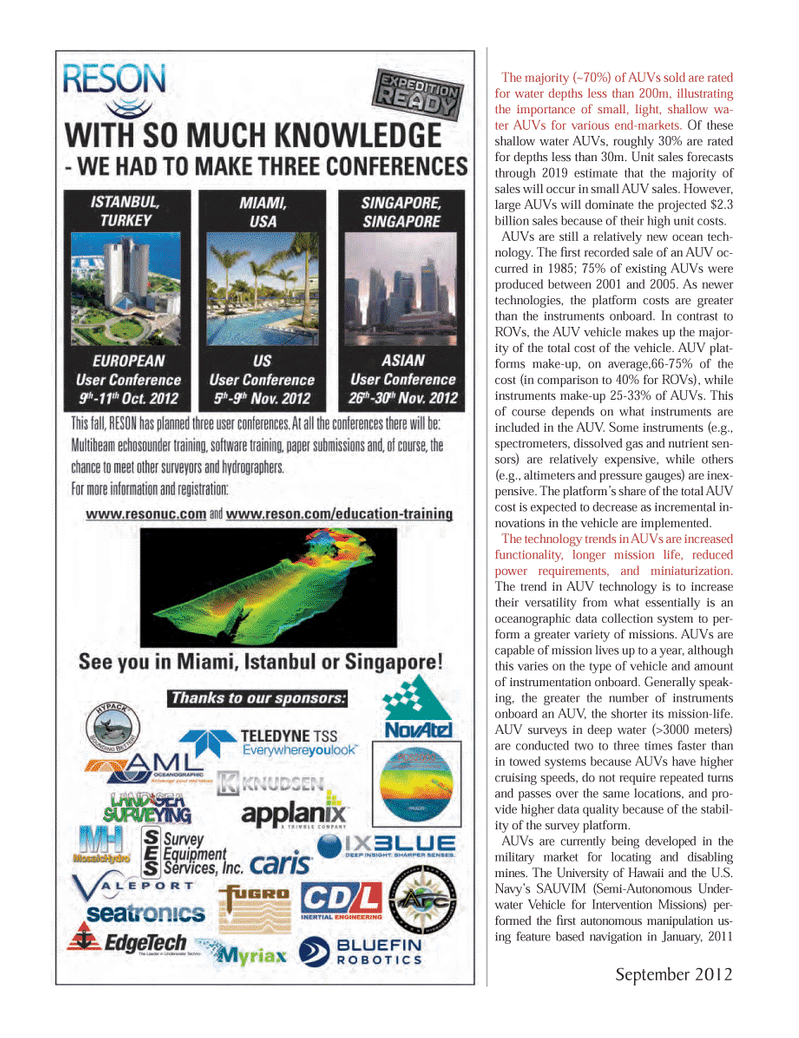
Page 50: of Marine Technology Magazine (September 2012)
Subsea Defense: Protecting Port & Subsea
Read this page in Pdf, Flash or Html5 edition of September 2012 Marine Technology Magazine
The majority (~70%) of AUVs sold are rated for water depths less than 200m, illustrating the importance of small, light, shallow wa- ter AUVs for various end-markets. Of these shallow water AUVs, roughly 30% are rated for depths less than 30m. Unit sales forecasts through 2019 estimate that the majority of sales will occur in small AUV sales. However, large AUVs will dominate the projected $2.3 billion sales because of their high unit costs. AUVs are still a relatively new ocean tech- nology. The Þ rst recorded sale of an AUV oc- curred in 1985; 75% of existing AUVs were produced between 2001 and 2005. As newer technologies, the platform costs are greater than the instruments onboard. In contrast to ROVs, the AUV vehicle makes up the major- ity of the total cost of the vehicle. AUV plat- forms make-up, on average,66-75% of the cost (in comparison to 40% for ROVs), while instruments make-up 25-33% of AUVs. This of course depends on what instruments are included in the AUV. Some instruments (e.g., spectrometers, dissolved gas and nutrient sen- sors) are relatively expensive, while others (e.g., altimeters and pressure gauges) are inex- pensive. The platformÕs share of the total AUV cost is expected to decrease as incremental in- novations in the vehicle are implemented. The technology trends in AUVs are increased functionality, longer mission life, reduced power requirements, and miniaturization. The trend in AUV technology is to increase their versatility from what essentially is an oceanographic data collection system to per- form a greater variety of missions. AUVs are capable of mission lives up to a year, although this varies on the type of vehicle and amount of instrumentation onboard. Generally speak-ing, the greater the number of instruments onboard an AUV, the shorter its mission-life. AUV surveys in deep water (>3000 meters) are conducted two to three times faster than in towed systems because AUVs have higher cruising speeds, do not require repeated turns and passes over the same locations, and pro- vide higher data quality because of the stabil-ity of the survey platform. AUVs are currently being developed in the military market for locating and disabling mines. The University of Hawaii and the U.S. NavyÕs SAUVIM (Semi-Autonomous Under- water Vehicle for Intervention Missions) per- formed the Þ rst autonomous manipulation us- ing feature based navigation in January, 2011 September 2012MTR #7 (50-64).indd 50MTR #7 (50-64).indd 509/10/2012 10:16:13 AM9/10/2012 10:16:13 AM

 49
49

 51
51
